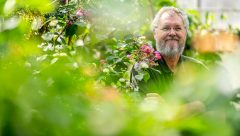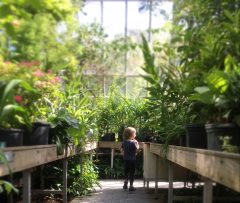Visit the Carleton Greenhouses

The two display greenhouses are accessed via the Nesbitt Lobby and are open to the public Monday to Friday 9:00 a.m. to 4:00 p.m. Display greenhouses may be closed without notice.
The research greenhouses down the hall from the lobby are off-limits; open to research personnel only.
Note that butterflies are only present in the butterfly greenhouse during the Annual Biology Butterfly Show in October.
The Nesbitt Lobby is a communal space used by biology staff and students. Outside requests to use the lobby or visit the greenhouses with a group must be directed to biology@carleton.ca and approved by the Chair of Biology.
For more information on the Carleton Greenhouses, contact Ed Bruggink
Teaching and Research
 Our Greenhouse Manager, Ed Bruggink, is responsible for all aspects of the greenhouses, which include all the growing and plant material required for research and teaching year-round. Undergraduate students are introduced to the greenhouses at the first year level and can continue to use the facilities in more advanced studies of plant morphology, biochemistry, biotechnology, physiology and plant/animal interactions, just to name a few.
Our Greenhouse Manager, Ed Bruggink, is responsible for all aspects of the greenhouses, which include all the growing and plant material required for research and teaching year-round. Undergraduate students are introduced to the greenhouses at the first year level and can continue to use the facilities in more advanced studies of plant morphology, biochemistry, biotechnology, physiology and plant/animal interactions, just to name a few.
Grown in our greenhouses – check out the giant palm leaf used for BIOL 2002 Plants: Form and Function.
About the Greenhouses
Carleton University has one of the best university greenhouse complexes in Canada. The greenhouses hold comprehensive plant collection of several thousand specimens ranging from popular crop species such as corn, soybean, papaya, banana and sugarcane to some quite unusual desert specimens. Welwitschia, usually found only in the Namib desert regions of South West Africa, resides in our own desert room.
Climate controlled display houses simulating tropical and temperate environments, 18 houses containing teaching and research material and a number of controlled environment chambers and rooms all make up approximately 10,000 square feet of a unique research, teaching and learning environment.
The Biology Department greenhouses were built in the late 1960s, and were designed with the help of Dr. John Webb, Dr. George Setterfield, Dr. Frank Wightman, and Hank Datema, who was curator of the greenhouses until his retirement in the fall of 1995. Originally, the facilities consisted of three display houses and 18 houses dedicated to teaching and research. When the Environmental Laboratories Biology Annex (ELBA) building was expanded, one of the display houses was removed.
 Location: Nesbitt Biology Building, Carleton University
Location: Nesbitt Biology Building, Carleton University
Hours of operation: 9:00 a.m. – 4:00 p.m.
Year opened: 1968
Normal temperature: 23 °C
Maximum temperature: 40 °C
Number of species: 300+
Number of plants in the greenhouses: 1,000
Number of greenhouses: 2 display, 12 research and course work houses
Total size of display greenhouses: 1,017 square feet and 618 square feet
Total size of research and course workhouses: 3,267 square feet
Fun Facts about the greenhouses
Amount of soil used per year: 182.4 cubic feet
Oldest plant: Ponderosa Lemon (California hybrid), pre-1980.
Most exotic plants: Poinsiana pulcherrima (West Indies), Camellia japonica (Japan-Korea)
Biggest flower: Sun and Sand Hibiscus (Australia): 22 cm wide
Plant with smallest maximum size: Lemna (duckweed): 1 cm
Tallest plant: Chorisia speciosa (floss silk tree): 7 metres
Average number of visitors per year: 10,000-12,000.
Strangest request: to use the greenhouses as a setting for a murder scene in the movie Posers, directed by alumna Katie Tallo.
In 2019, our Queen Victoria Agave bloomed! Read the full story here.
Greenhouse Highlights from our Social Media
The Corpse Flower blooms annually. Yep. It stinks. 👃
View this post on Instagram
All of the plants you see at Convocation are grown on campus in our greenhouses! 🌼
View this post on Instagram
The butterfly greenhouse fills with beautiful butterflies every October. Come check out the Annual Biology Butterfly Show! 🦋
View this post on Instagram
[top]
